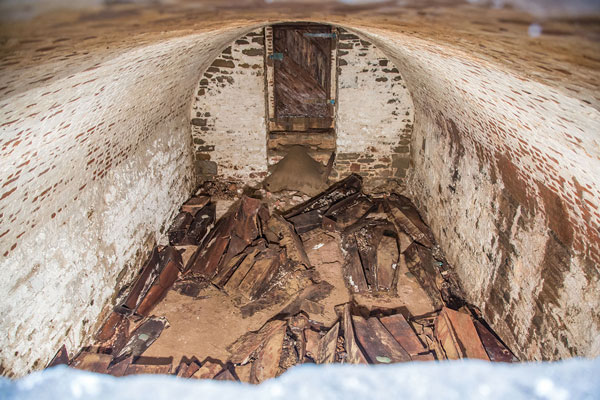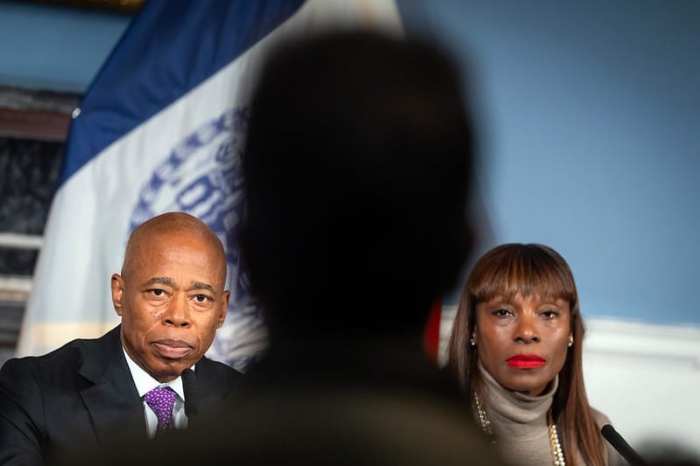
A close-up view inside one of the two burial vaults. This vault’s contents — including coffins with metal nameplates — were in better shape than the other one, which contained scattered skeletal remains previously disturbed by a 1960s Con Ed project. Photos courtesy NYC Dept. of Design and Construction
BY LINCOLN ANDERSON | City workers were “fixing a gasket,” but wound up uncovering hoary caskets, along with scattered human remains, last week on Washington Square East.
According to a spokesperson for the city’s Department of Design and Construction, the agency is in the process of replacing century-old trunk and distribution water mains under the street on the east side of the park, near the intersection of Waverly Place.
Shavone Williams said D.D.C. was “being proactive” in replacing the existing 50-year-old mains, which have a 100-year lifespan.
The first of two underground burial vaults, containing skeletal remains in disarray, was encountered on Tuesday. The following day, a second vault, containing about two dozen coffins, was found south of the first one. At that point, construction on the project was halted, Williams said.
The vaults are each 4 feet below street level, 8 feet high, 15 feet wide and 20 feet long.
Archaeologists and anthropologists from D.D.C. and also the Landmarks Preservation Commission were called in to investigate the vaults. This is being done with probing cameras, as opposed to entering the spaces.

Both vaults’ contents are believed to date to the early 1800s and be connected to Presbyterian churches then on Pearl and Cedar Sts.
In a statement, Commissioner Peña-Mora said, “D.D.C. will prohibit work at the specific location, to permit further evaluation by archeologists and anthropologists. Working together with the Landmarks Preservation Commission, D.D.C. will continue to evaluate the extent and significance of the vault and its contents.”
The D.D.C. spokesperson added that the water-main project is currently being redesigned so as to “minimize the impact” on the historic tombs.
The New York Times reported that both the Cedar St. and Pearl St. Presbyterian churches were associated with the Scotch Church. Both had burial plots in the vicinity of Washington Square, which by 1800 had been designated by the city as a potter’s field, a burial ground for unknown or indigent people.
The Cedar St. Church evolved into today’s Fifth Ave. Presbyterian Church, at E. 55th St. and Fifth Ave. That church does have records in its archives.
In a Nov. 7 note to members, Scott Black Johnston, the church’s senior pastor, wrote, “We are in touch with the archaeologists and have offered our help in matching [our] archival records to the physical evidence that rests below Washington Square.
“What makes this discovery all the more fascinating,” he added, “is that it comes on the eve of our anniversary. The Cedar Street Church was organized on Nov. 8, 1808 — exactly 207 years ago tomorrow.”
If the remains are associated with what became the Second Presbyterian Church, at Central Park West and 96th St., however, researchers will be out of luck, since that church did not keep records, the Times reported.
Meanwhile, some slammed as boneheaded the city’s decision to dig in the same spot, since the first vault and its bones had been disturbed during a Con Ed project 50 years ago to install a transformer.
“Shame on the planners of this project!” Mary Johnson, a former Community Board 2 member who lives on the east side of the park, wrote to a D.D.C. community liaison for the project. “What I know is that at least two church cemeteries — one on Waverly Place and one on Washington Place and what today is Washington Square East — were moved into Washington Square at the time its perimeter was renovated into park space in the 1800s.
“Good grief! This is the Greenwich Village Historic District! Was there no research done by your architects and engineers? What about Con Ed’s records — I cannot believe they once again disturbed this same burial place! Very poor planning. And how can they be so surprised?”
Similarly, Andrew Berman, executive director of the Greenwich Village Society for Historic Preservation, making no bones about it, said, “I certainly would say it was a reasonable assumption, if you’re going to be digging in this location, there was a good likelihood of hitting burial sites.”




































